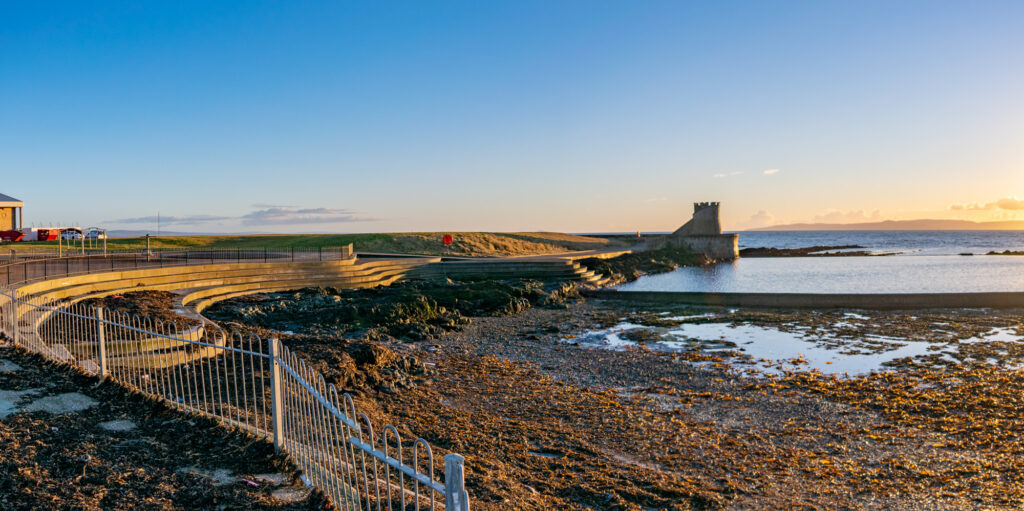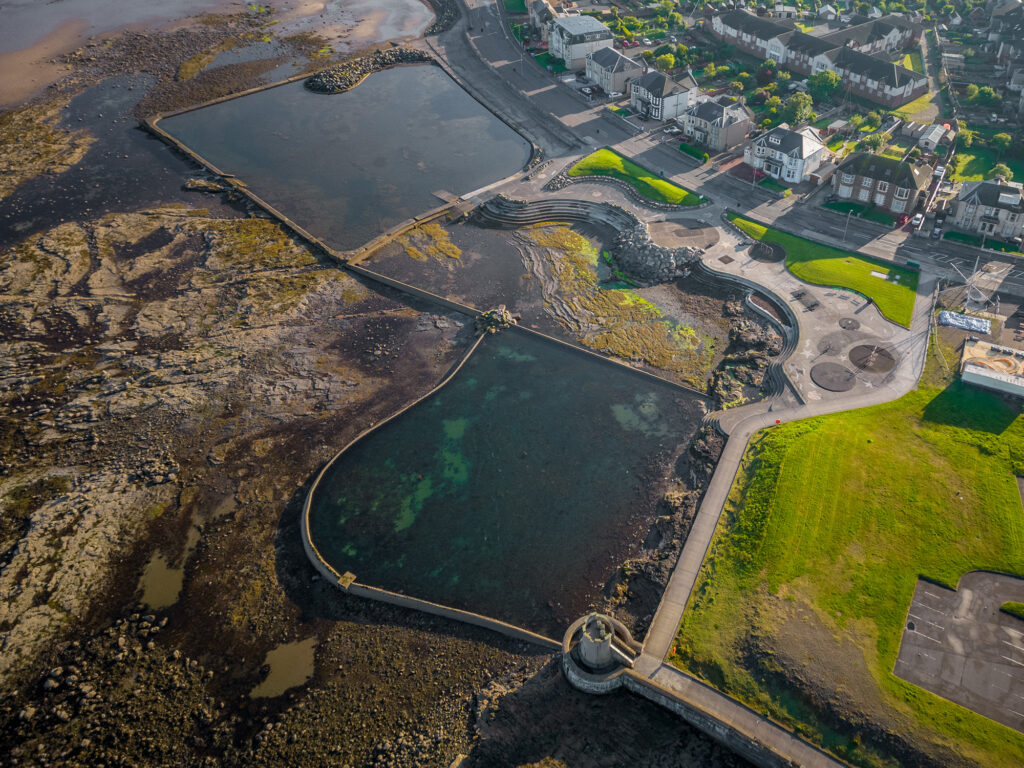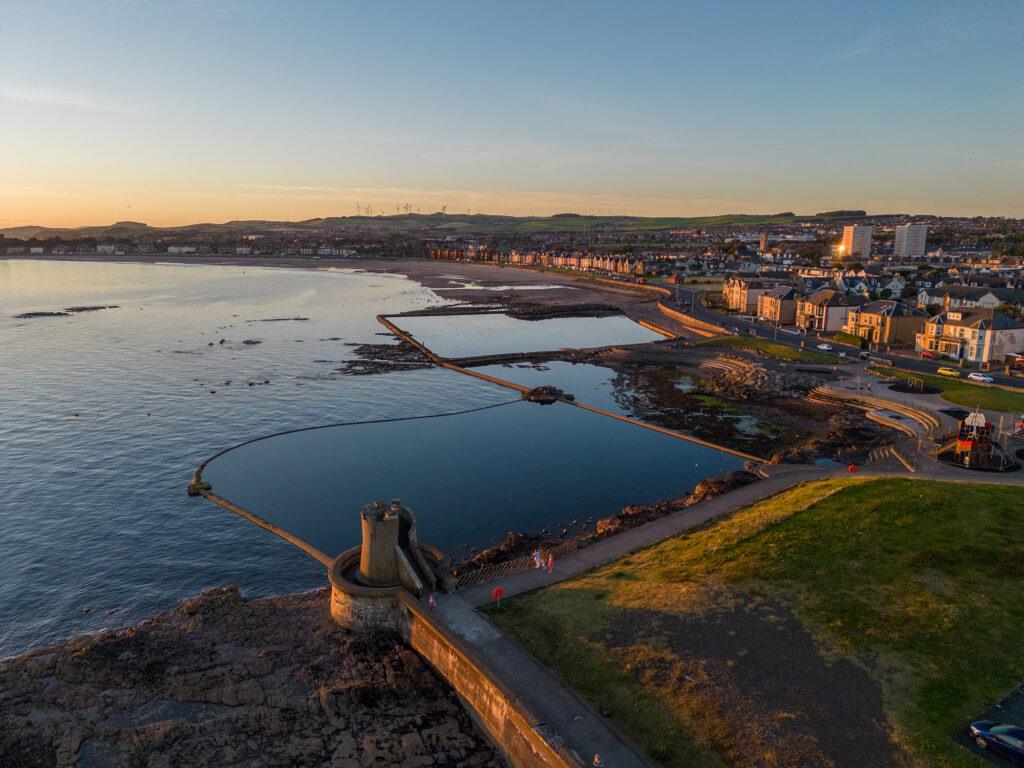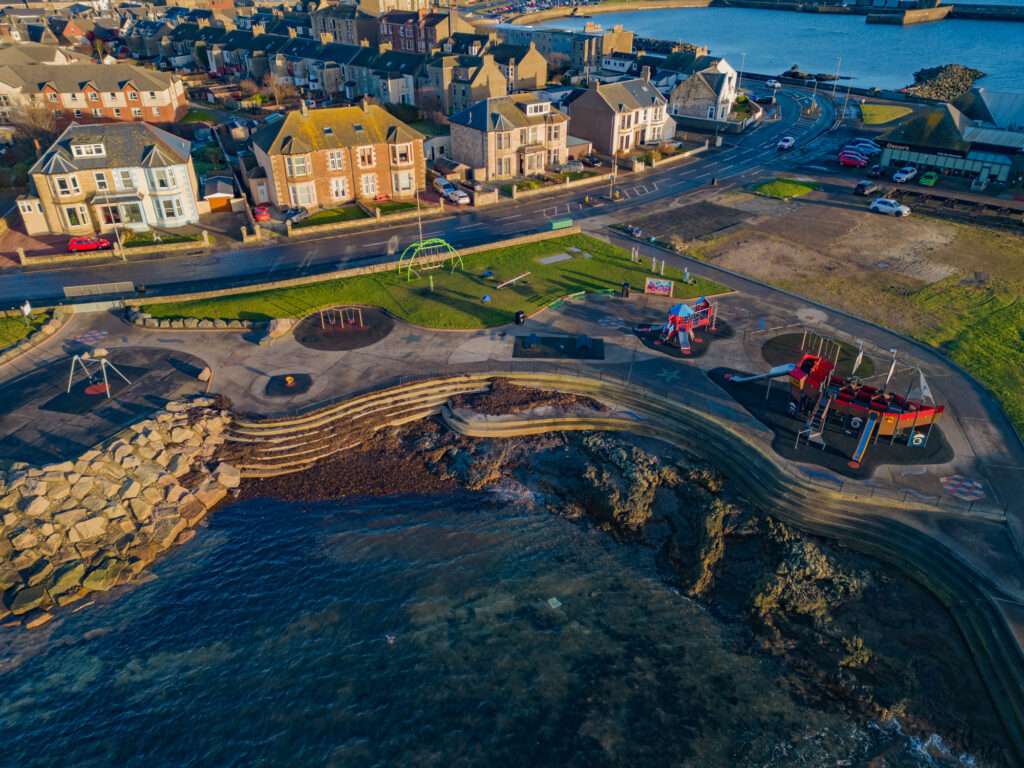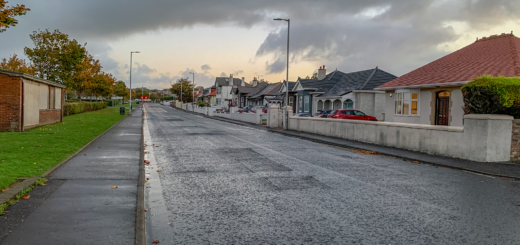History of the Saltpans Bathing Place
Introduction
The Saltpans Bathing Place, once Scotland’s largest tidal pool, has it’s origins in one of Saltcoats’ other former industries. The town’s very name gives away its history and ties with the salt-making trade. Salt pans were used in salt production, but by the end of the 18th century only two pans remained: the South Pans at the harbour, belonging to the Cunninghames, and the older North Pans, belonging to the Earl of Eglinton, at the far end of Windmill Street, near what’s said to be the site of the “Castleweerock”, a Picts castle from centuries ago.
The North Pans were still operational as late as the 1830s, but by the 1850s they had fallen into ruin. The ruins further deteriorated over time, hastened by the removal of stone around 1876 for use in the construction of nearby Winton Circus. A heavy storm over the weekend of the 26th-27th January 1884 washed away most of what was left of the pans, leaving little more than the gable end and part of the eastern wall of one of the buildings.
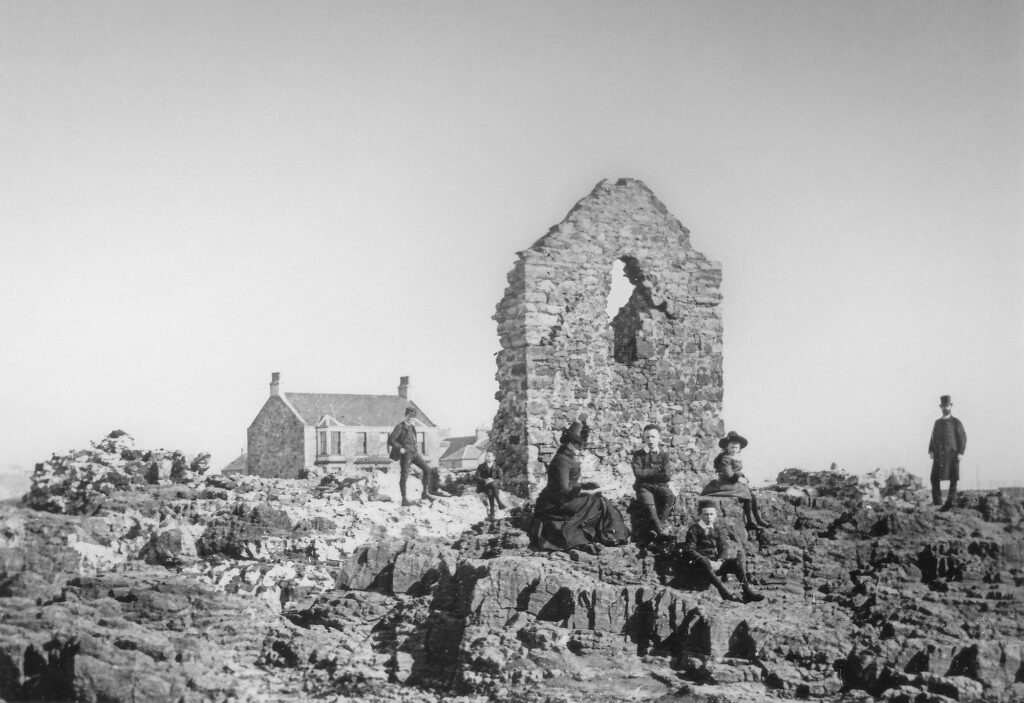
Image courtesy of North Ayrshire Council, Heritage and Cultural Services.
The Bathers’ Club and the First Bathing House
Later in the 1880s the area started to become a popular bathing spot for locals and visitors alike. By 1893 calls for Saltcoats Town Council to create better facilities had gone unanswered, and so the Saltcoats and Visitors Bather’s Club was founded.
BATHING FACILITIES
As our Commissioners have turned a deaf ear to the requests of bathers for assistance in improving the facilities, a movement is afoot to form a Bathers’ or Visitors’ Club among those usually resident in Saltcoats and South Beach during summer. It is also proposed, if possible, to improve boating facilities; and towards these objects plans have been suggested which give every promise of success.
From the Ardrossan & Saltcoats Herald, 27th January 1893.
Once formed, the club soon petitioned to the commissioners that better bathing facilities become available. The Saltcoats Commissioners met at the Town Hall on Monday 24th April 1893 to discuss and, agreeing that it would benefit Saltcoats, particularly in the summer months, they contributed £25 towards improving the area. Improvements included building a 4ft wide concrete platform, laying out a path to the platform, and clearing out stones and seaweed from the seabed.
The club themselves requested permission to build a small wooden pavilion for use as a bathing house, which was granted, and so the first Saltpans Bathing House was built in early June 1893. It was constructed inside the salt pans ruin, just south of the original basic shed that provided bathing facilities up till that point. At the same time, the council decided to organise repair works to the North Pans ruin, including pointing work and tidying up the “window” on the gable end to look more attractive to visitors.
The local authorities were not impressed with the plans for the wooden pavilion and the idea that it would remain up all year long, with one member describing it as a “tramp’s howff” and another predicting that it could be swept away by winter storms. The opening ceremony for the bathing house took place on Saturday 23rd June 1893 and was attended by the president of the Scottish Swimming Association. There had planned to be a display of swimming from the club on the day but this was cancelled due to the weather and the tide.
Upon opening, the bathing house was allowed to be used by women exclusively for a single hour per day. As well as funds received from members for their yearly subscription, the bathers’ club also held fundraising events, such as a concert in the town hall on Friday 28th July, 1893 featuring pianists, violists and singers.
The first season of the club came to an end on 31st August 1893 and was deemed a huge success. In the first year of its existence the club had gained nearly 130 members.
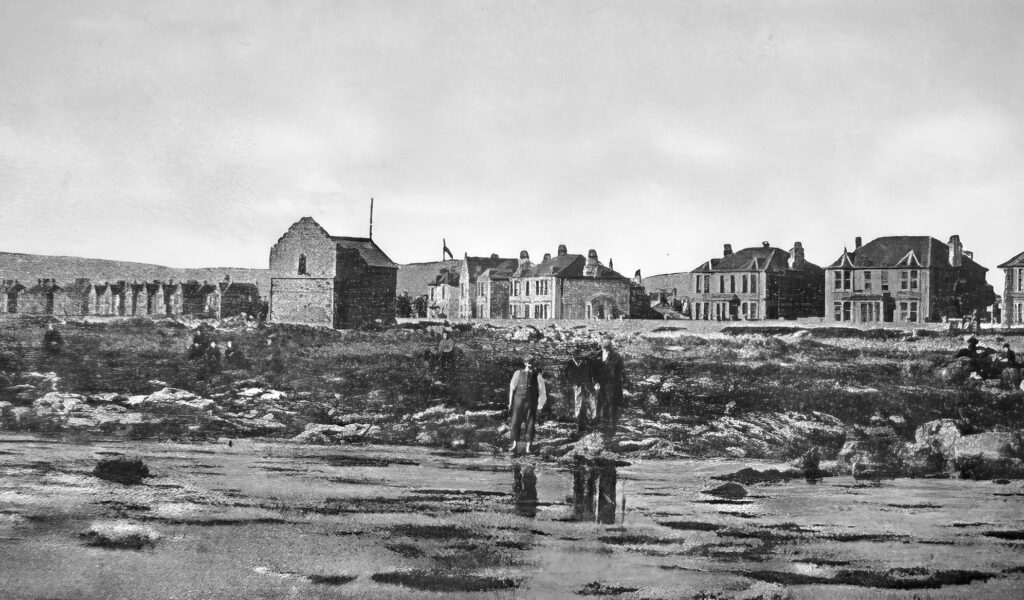
Early Improvements
In February 1894 members of the bather’s club met with Saltcoats Commissioners to discuss further improvements to the facilities at the North Pans, including extending the concrete platform to the low tide mark and further clearing away loose stones and seaweed. The estimated cost was £80-90, with the club requesting that the Commissioners pay £40, which it took nearly 2 months for them to agree to.
Improvement work began in early April, overseen by Walter J. Grant, a builder from Shettleston. Two additional pieces of work were done during construction: a concrete butt was added for diving in front of the platform, and the basin formerly used for salt manufacturing was deepened and given a concrete floor. As a result over 500 tons of rock was excavated during the project. The final cost of the improvements was £125.
The improved facilities opened with a ceremony on Saturday 26th May. For its second season, the club allowed two hours a day for women to use the bathing house.
By the end of 1894, membership of the club had grown to 224 members. Despite this, the club was operating at at loss and began the 1895 season with a deficit of £34 6s 2d, primarily due to the high cost of the improvements the previous year. The club also changed its name to “The Saltcoats and Visitors’ Bathing Club”. At the end of 1895, membership had dropped to 179 and the club still had a deficit of £34. Suggestions for further improvements such as a diving ladder were put on hold under more funds were available.
In December 1895 the Shores and Amenities Committee was formed by the Saltcoats Commissioners to investigate improvements in that area, including the bathing facilities. By May 1896 the commissioners agreed to take ownership of the bathing house and surrounding land, and to enhanced the facilities further by building walls, an approach road and placing bathing boxes. Nothing happened immediately as it took some time to purchase the land from the Earl of Eglinton, which was eventually finalised in late 1898.
SALTCOATS AND VISITORS’ BATHING CLUB
The fine weather of the past week has favoured the opening of this club. Already there is a good membership, both of the visitors and residents. The Burgh Commissioners are now in possession of the bathing ground, and are making some much needed improvements in the bathing channel. All loose stones have been removed, and it is intended to remove a portion of the rock. The club has reduced the subscription for the season to 2s 6d.
From the Ardrossan and Saltcoats Herald, Friday 9th June 1899.
The Second Saltpans Bathing House
On Thursday 20th December 1900, the original bathing house was completely destroyed by a storm, leaving nothing but the old saltpans ruin once again, along with some concrete steps and a noticeboard. It would appear at this point that the Bathing Club disbanded, likely due to their main asset being washed away.
The town council came under pressure to do something, especially as the summer of 1901 came and went without any meaningful bathing facilities on the shore front, aside from a small bathing box that was placed on the sea side of the old saltpans ruin. As a result, in February 1902 plans were drawn up for a new bathing house. Mason work was carried out by A. Cuthbertson & Son, with joinery completed by A. McIntyre. The new bathing house, composed of brick with a corrugated iron roof, was built directly on to the gable end of the old salt pans. A crowstep feature was added to the top of the ruin to match the new land-facing gable end. William Millar of Windmill Street was appointed as the Bathing Attendant. The new facilities had opened by the start of July 1902.
The house, which accommodated twelve bathing boxes, was considered to be too small and cramped:
BATHING FACILITIES AT SALTCOATS
The Bathers’ House, erected on the West Beach at Saltcoats, does not meet with general approval. Outwardly no fault is found with the erection, but the internal arrangements are voted unsatisfactory. There are twelve boxes, each of which is understood to accommodate a bather, but the space allotted is too small. There is no room for action, a very necessary and desirable procedure after a bathe, and it is very doubtful if cribbed seclusion is worth all that has been sacrificed. The feeling on the part of bathers is that rocks are preferable to the boxes, in which case the income will not realise the Council’s expectations. That is of less importance, however, than meeting the wishes of the bathers, and in the matter of accommodation, hours, and attention on part of the attendant, we trust the Shores Committee will be open to suggestions.
From the Ardrossan and Saltcoats Herald, Friday 11th July 1902.
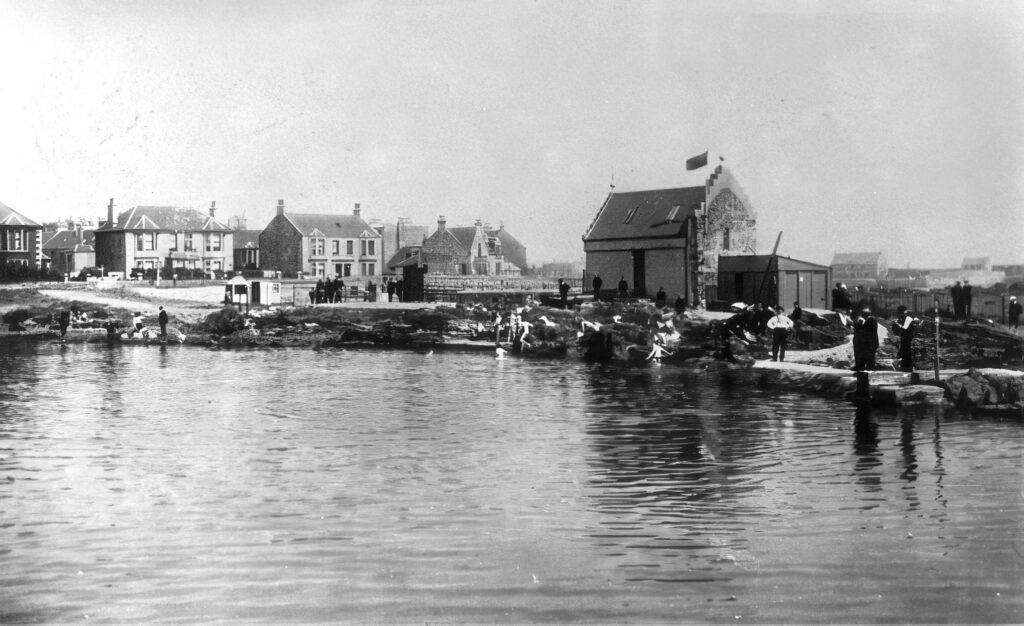
The Bathing Pond
In November 1903, the town council considered building a large bathing pond next to the bathing house, however within a few months it was decided not to proceed with the project. The idea of the bathing pond was put forward several times over the next few years, and was always eventually rejected. As a result of the council’s refusal to make any further improvements to the bathing facilities, the Bathing Club was resurrected in October 1906, who once again petitioned the authorities to make changes. In March the following year, the majority of the council voted to construct the pond.
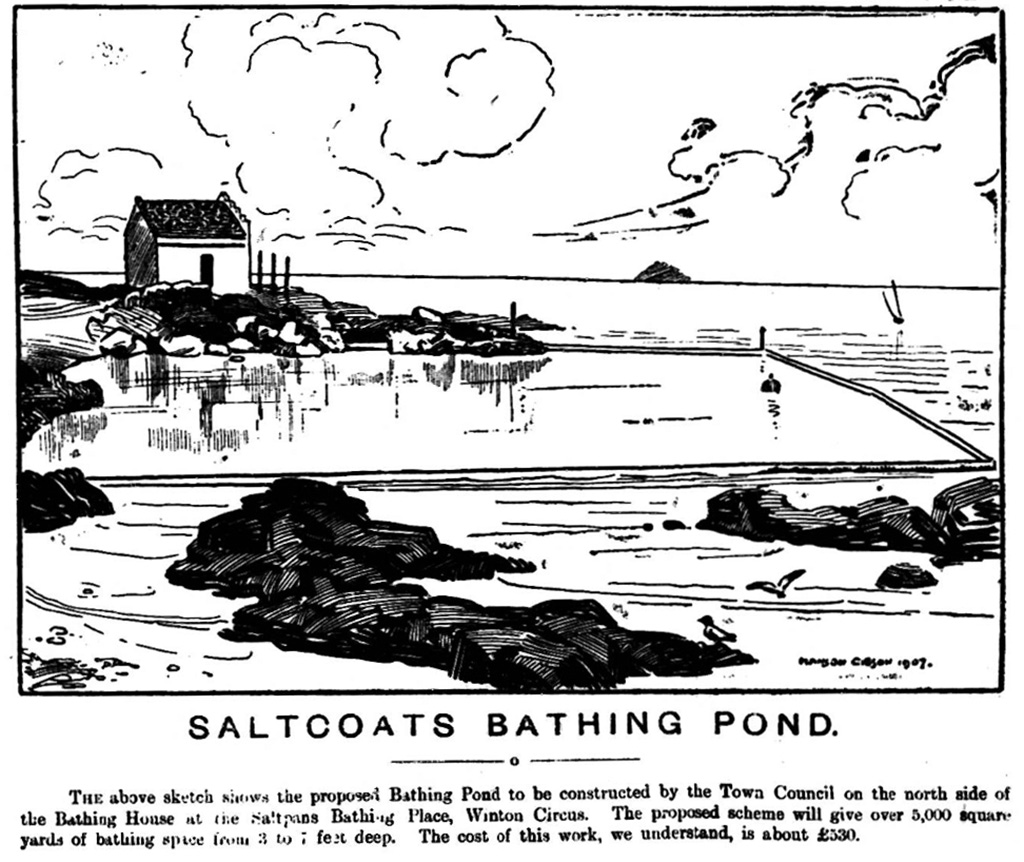
Work began on Monday 3rd June 1907, with the pond expected to be ready for the Glasgow Fair week. However various problems delayed the opening of the pond by a year. The new pond officially opened on Saturday 27th June 1908 with an inauguration gala.
In August 1908 the President of the Scottish Amateur Swimming Association called for Saltcoats to embrace the idea of “mixed bathing”, i.e. both sexes bathing at the same time.
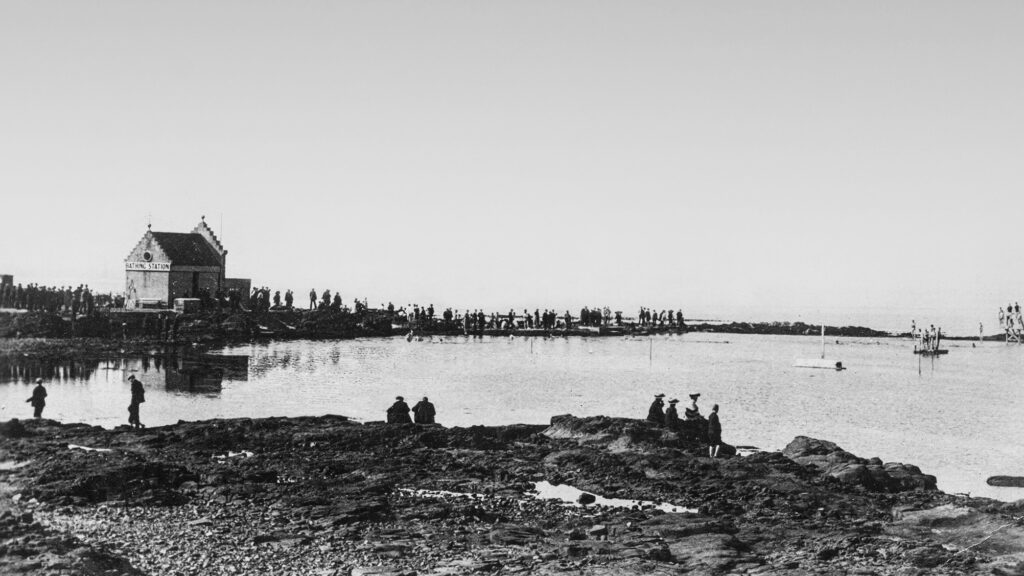
Also in 1908, the Bathing Club proposed a new pavilion be built at the pond for their own private use, and had plans drawn up for a structure that would sit next to the original building on the land side. It was to have a flat roof that would be used as a gallery for spectators. The council objected to the location, preferring it to be on opposite side of the bath house, next to the sea. This was eventually agreed by the club in early 1909 and so the new building, slightly smaller than originally envisioned, was opened in the summer of that year.
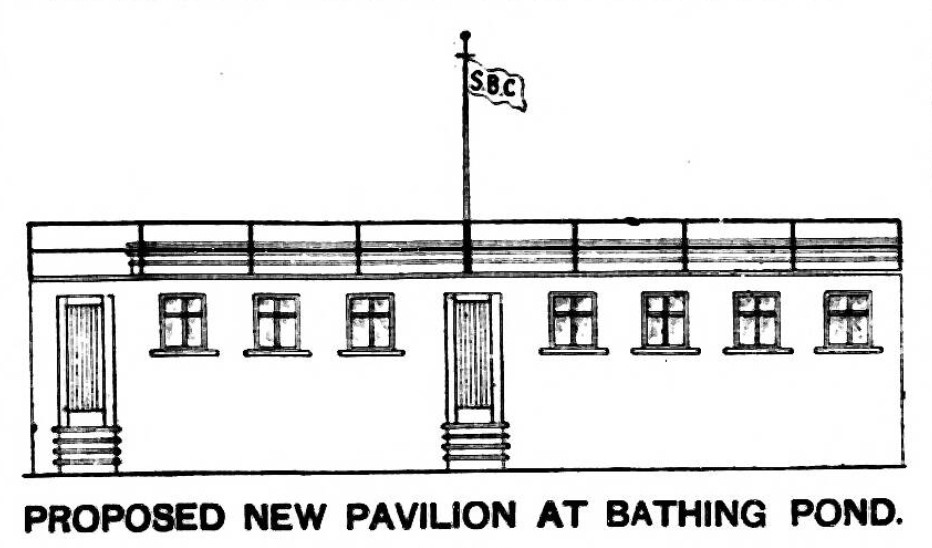
At roughly the same time the town council built an extension at the land side of the bathing house, similar in style to the original building, providing entrance/exit turnstiles and lavatory facilities. A water chute was also installed that year to huge success.
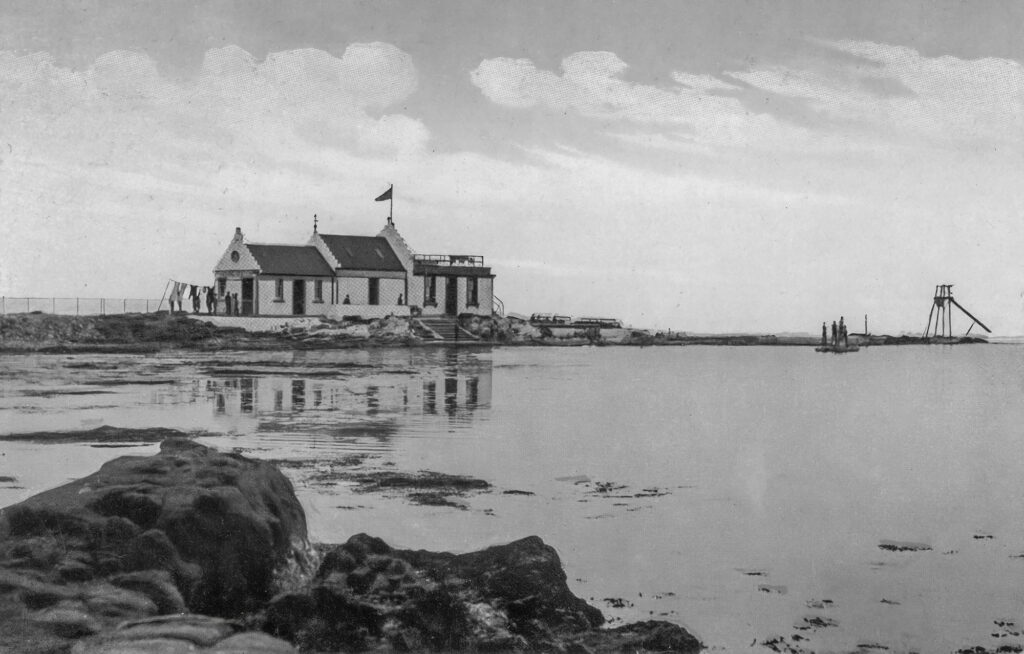
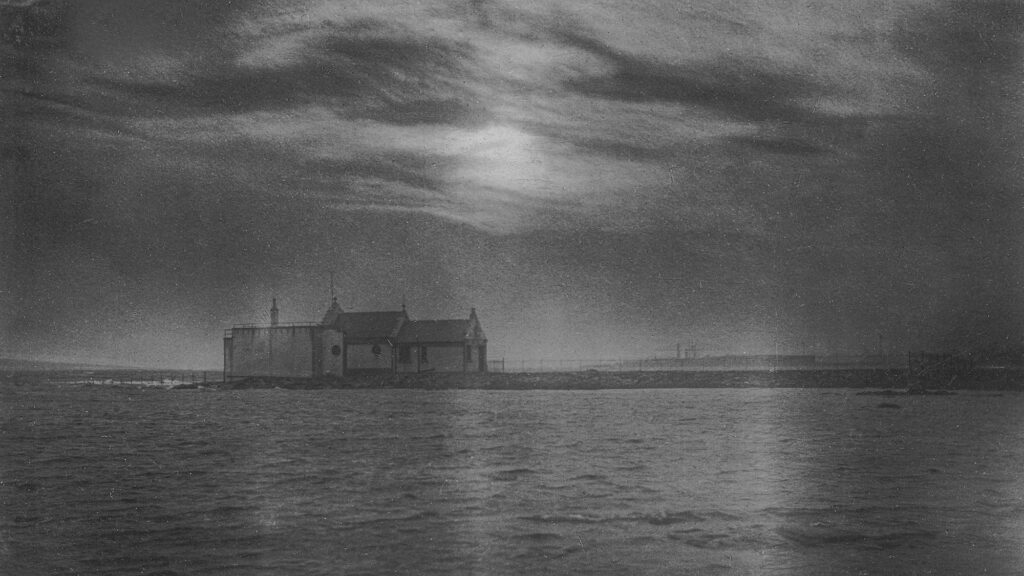
The pond grew from strength to strength, with the summer season of 1910 being the most successful so far for both the pond and the Bathing/Swimming Club, with as many as 1000 visitors during one day.
Further Improvements to the Saltpans Bathing Place
On Saturday 22nd June 1912, the newest extension to the bathing pond opened. At this point the pond itself was split into two, with one side for female bathing and the other for males. In December 1912, the town council agreed to allow mixed bathing at the pond next season for a limited period each day.
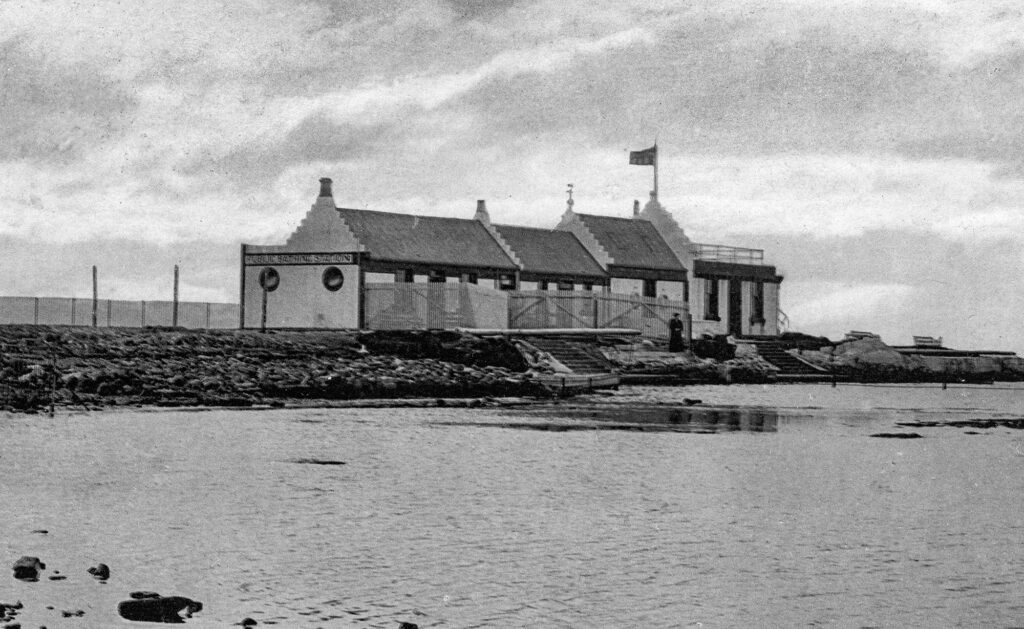
The bathing club, by this point known as the Saltcoats Amateur Swimming Club, once again met with Saltcoats Town Council on 27th October 1913. They had a list of suggestions for the council relating to the bathing pond, the first of which was to provide dedicated ladies dressing accommodation. Initially the council proposed to use old tram cars as accommodation, but it was agreed in January 1914 to construct a moveable wooden building, 30ft by 10ft with a corrugated iron roof at a cost of around £50. The new section would be built on to the sea side of the bathing house, adjoining the 1909 club house. It was also decided that a wash house with a portable boiler would be built on the shore side, at a cost of around £10.
Attendance at the pond continued to grow: there were 50,253 visitors in 1914 compared to 36,709 in 1913.
In 1922 yet another extension was added to the north side of the building, providing new, larger dressing rooms for women and children.
The following year an improvement scheme was approved by the town council to wall off a portion of the pond for use as a children’s yachting/boating pond, including new concrete terracing. John Bannatyne’s quote of £950 12s 6d for the work was accepted by the council, and work began in April 1924. The construction didn’t go smoothly for a number of reasons. First was a lack of bottoming material for underneath the terrace: although brick and stone from a recently demolished property at 7 Bradshaw Street that belonged to James C. Reid was used, it wasn’t enough, resulting in the some of the walls running along Winton Circus being utilised. Secondly, strong winds and high tides on 22nd-27th December 1924 resulted in damage to the new terracing and the pavement in front, leading to a dispute between Bannatyne and the council as to who’s responsibility it was to pay for repairs.
Around this time a new road was constructed on the eastern side of the bathing place, directly adjacent to it and running from Winton Circus in a south-western direction towards the sea. The road was named, appropriately enough, Saltpans Road. The piece of ground around the wash house was also concreted, at an estimated cost of £170.
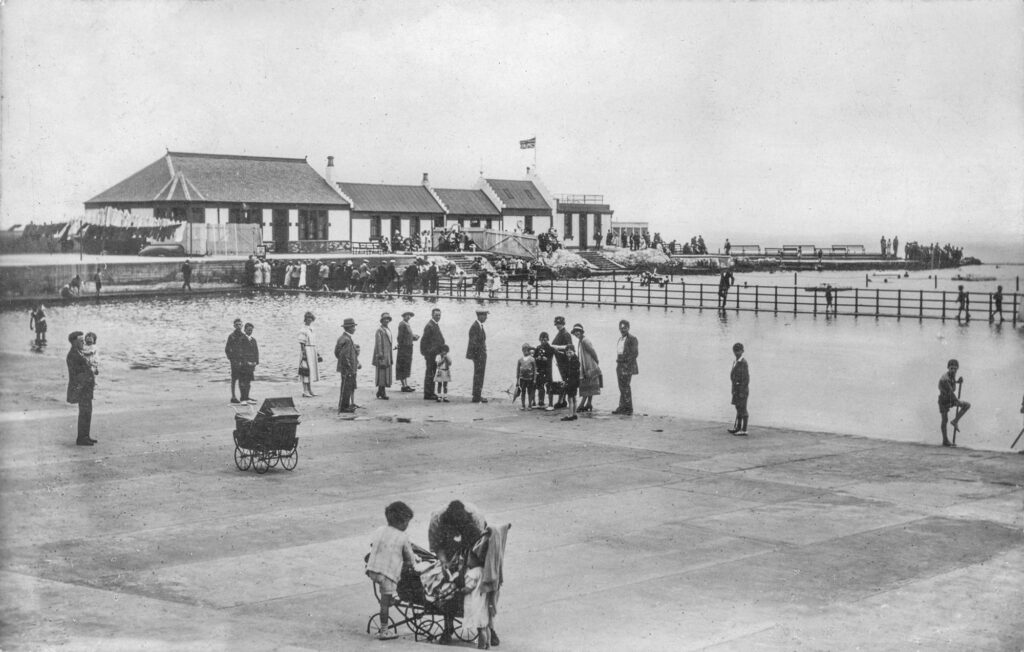
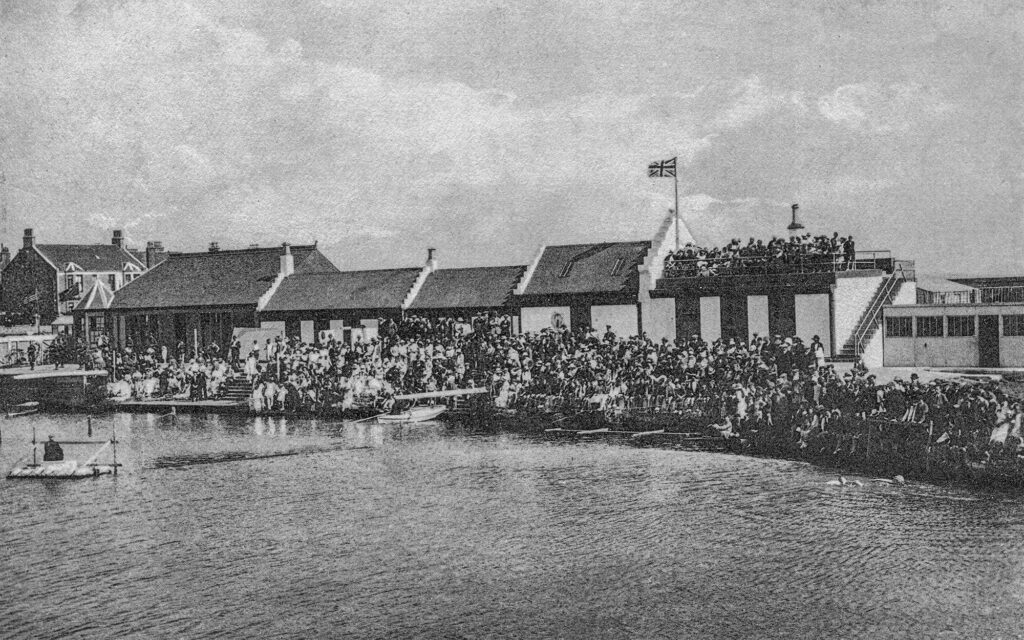
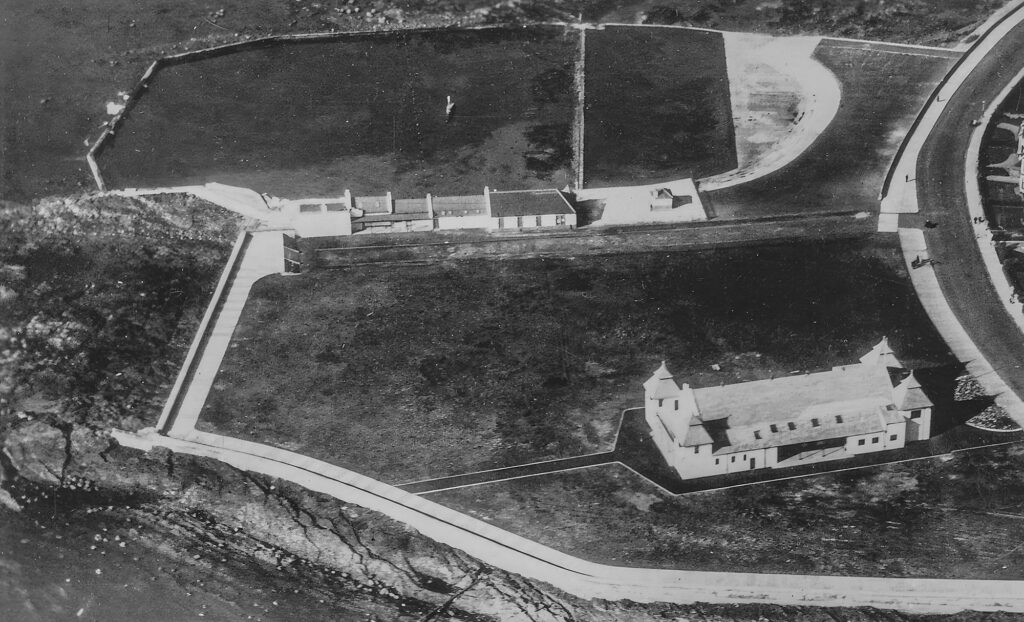
Despite the improvements, the swimming club raised the issue that more work still needed done:
Read Letter, dated 7th October, signed by Mr Robert S. Brown, President, and Mr R. W. Thomson, Secretary of the Saltcoats Amateur Swimming Club, directing attention to the condition of the Saltpans Bathing Place, particularly the Dressing Accommodation, which was quite inadequate, and stating that, if the Town Council could see their way to improve matters, the Saltcoats Amateur Swimming Club would be willing to give all possible assistance in getting more bathers to use the Station regularly, and so increase the income to meet any expense which may be incurred.
Resolved that the Letter be continued for consideration by the Committee after the Election.
From the minutes of the Shores and Improvements Committee of Saltcoats Town Council meeting held on 25th October 1926.
The Reconstructed Saltpans Bathing Place
By 1930, it became even more clear that the buildings at the bathing place were starting to need major work: not only was the oldest section nearly 30 years old, but it also still remained built on the much older gable end of the salt pans ruin. On 1st February 1930, the Shores and Improvements Committee met at the Saltpans Bathing Place to discuss a number of improvements that could be made to the site, one of which was to consider the complete overhaul and reconstruction of the building.
Plans were set in motion, and a number of steps were taken including the committee visiting similar locations along the Lancashire coast in September of that year. Preliminary plans were drawn up shortly after, but work did not start immediately, primarily over the issue of funding. Work had still continued to improve the existing buildings, such as offices being installed at the entrance by closing off a portion of the veranda and partitioning off part of the kitchen.
In September 1932 George Harley, the Burgh Surveyor, was again asked to submit a plan and cost report, with the intention of completely reconstruction the building aside from the 1922 extension, which was being used for woman and children’s dressing rooms, and to build a new concrete terrace for spectators. The report put initial estimated costs at £2500 for the reconstruction and £1100 for the terracing. This was soon revised to an estimated £5800, presumably including demolishing the 1922 extension as well.
Tenders went out for the construction work, and the following quotes were accepted:
| Reinforced Concrete – Wm. Paton & Sons, Ayr | £3,567 8s 1d |
| Mason – R. W. Kennedy & Son, Gladstone Road, Saltcoats | £51 1s 8d |
| Asphalte – Limmer & Trinidad Lake Asphalt Co. Ltd., 45 Hope Street, Glasgow | £391 1s 8d |
| Plumber – Chas. Price & Son, 2 Princes Street, Ardrossan | £134 17s 7d |
| Joiner – Dugald McCallum, 30 Eglinton Street, Saltcoats | £273 11s 9 1/2d |
| Glazier – Dugald McCallum, 30 Eglinton Street, Saltcoats | £55 3s 3d |
| Plaster – Wm. Sinclair & Sons, 16 Canal Street, Saltcoats | £349 4s 4 1/2d |
| Electric – David Robertson, 42 Glasgow Street, Ardrossan | £14 19s 5 1/2d |
| Smith – Ramage & Whitehead, 160 Fielden Street, Glasgow | £23 14s |
| Painter – Robt. Main, 52 Hamilton Street, Saltcoats | £78 7s 9 1/2d |
| Windows – Maclean & Co., 145 Bath Street, Glasgow | £150 4s |
| Total | £5089 13s 8d |
Additional costs for shutters, turnstiles, the demolition of the old building, etc put the total cost at £5726 13s 8d.
Construction of the new pavilion work got underway towards the end of 1932, and with it the last remnants of the old North Pans ruin would have been lost. Preparations began for the new Saltpans Bathing Place to open in the summer of the following year. Outfits for the staff and swimming costumes for swimmer use were both provided by Robert Duncan. Tenancy of the new tea room was given to Daniel Bonaldi. Attendants were appointed for the dressing rooms: Isabella H. Armour for the female dressing room and John Wilson for the male dressing room.
The opening ceremony for the new facilities was Saturday 10th June 1933, with regular admission costing 7d, ordinary seats costing 1/2d, and reserved seats 2/4d. Alexander B. Swan, the Lord Provost of Glasgow, was invited to perform the opening ceremony.
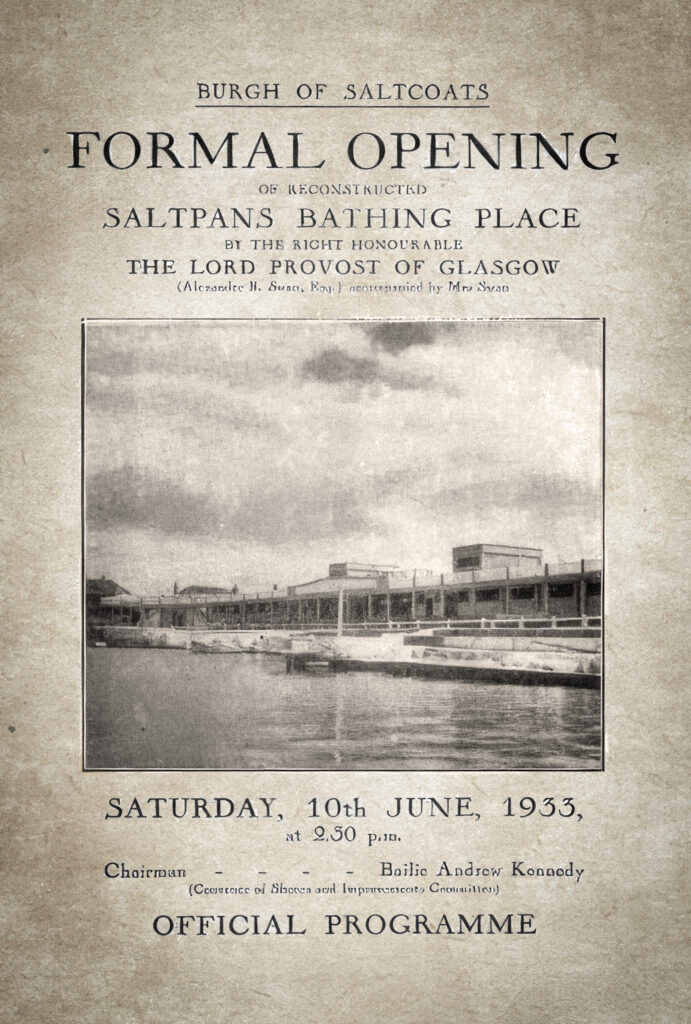
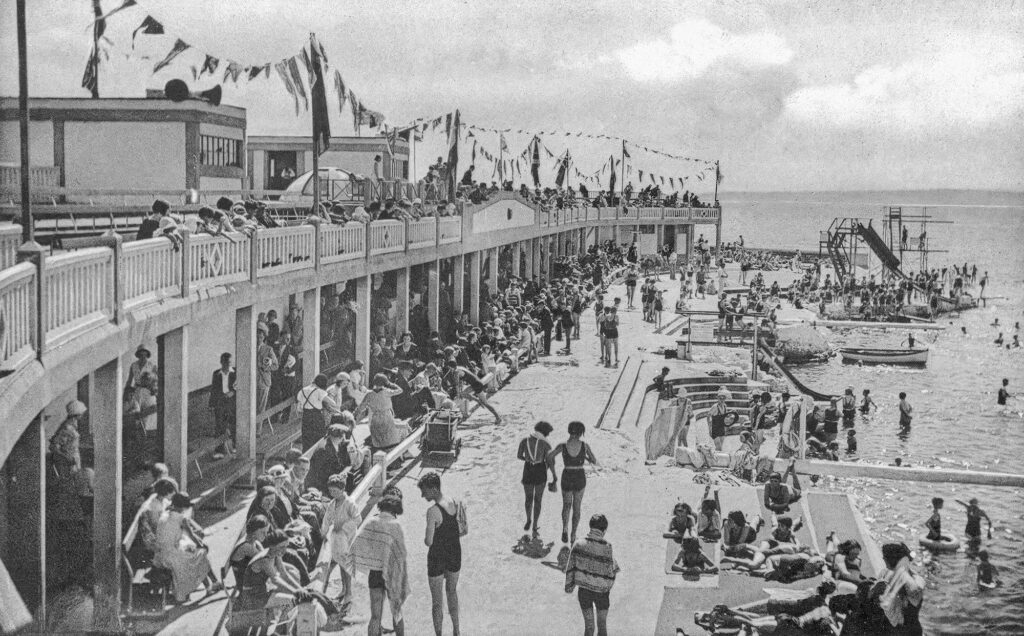
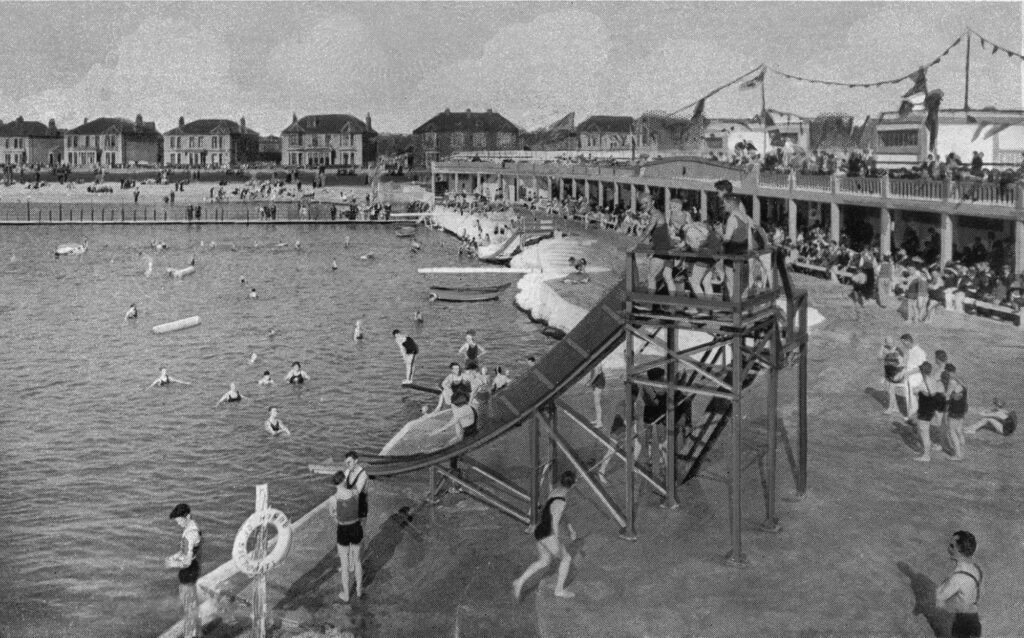
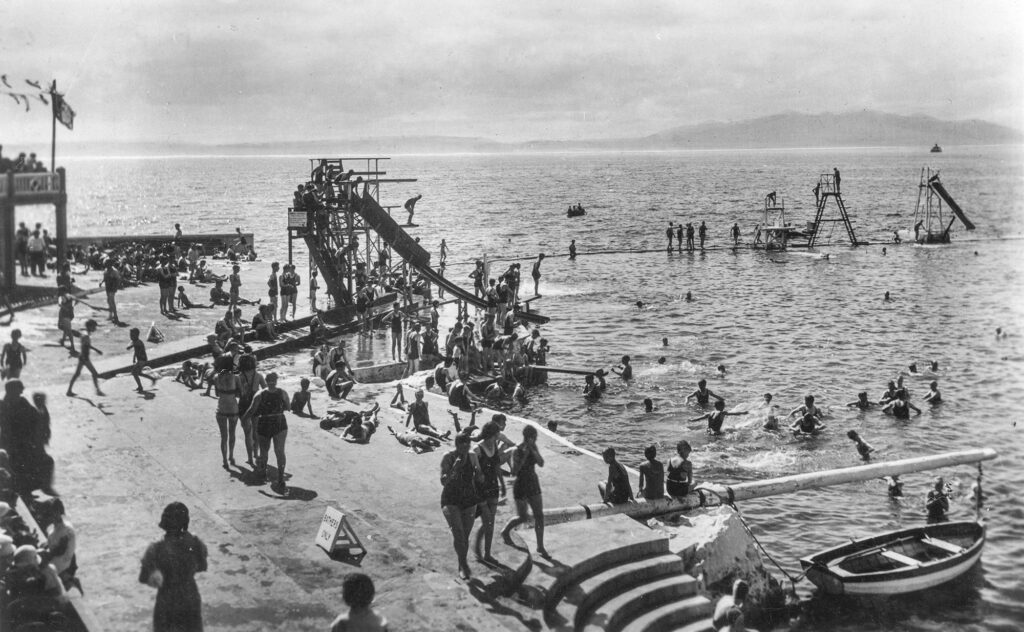
Initially the new pavilion lacked outdoor lighting, but this was installed around August 1933 after the council accepted a tender from Gregor Watson to supply and fit the equipment. This allowed the pond to remain open in the evenings, depending on the weather.
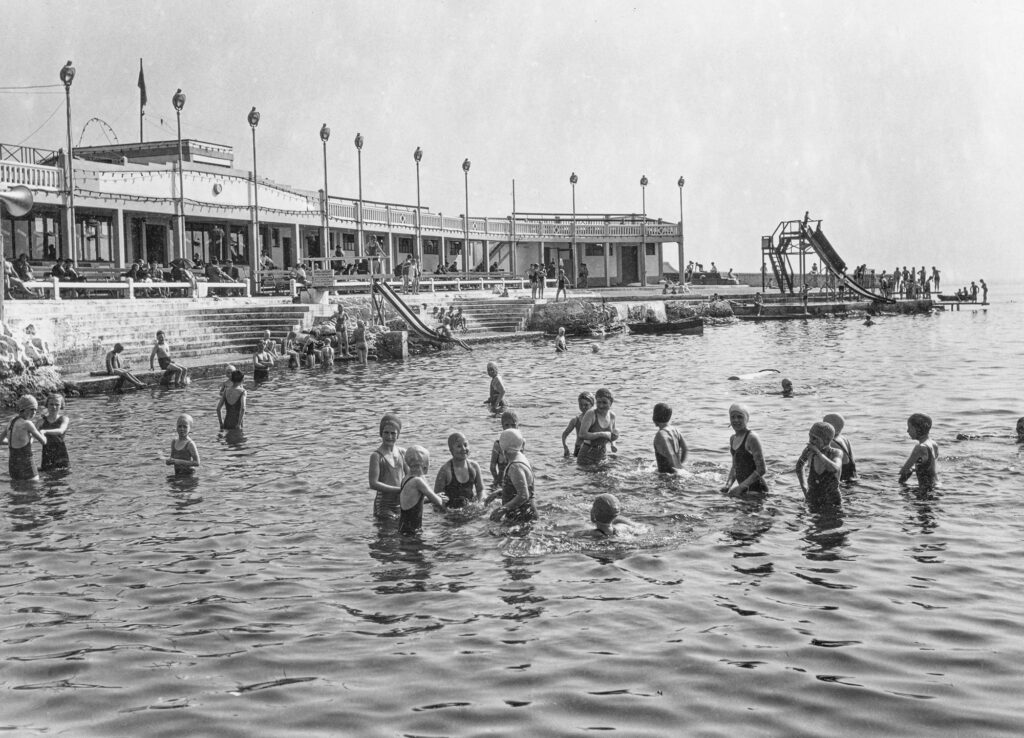
The New Model Yachting Pond
At the end of 1933, the recently formed Saltcoats Model Yachting Club requested that a new, larger yachting pond be built to the west of the existing pond. The Burgh Surveyor drew up plans in January 1934 and estimated the cost of the works to be roughly £2208. The plans had the backing of the Scottish Model Yacht Assocation, who advised it would transcend any current pond available in Scotland and would attract model boating clubs from around the country for matches to take place.
The plan was approved, with Hugh Leggat Ltd. of Barrhead carrying out the concreting work. An opening ceremony took place on Saturday 9th June 1934:
NEW MODEL YACHT POND AT SALTCOATS
Lieutenant-Colonel T. C. R. Moore, M.P. for Ayr Burghs, on Saturday opened the new model yacht pond which has been built by Saltcoats Town Council, in the presence of 5000 spectators. The pond covers an area of 2 1/2 acres, and has been built on the beach opposite Winton Circus at a cost of £2000. Provost Kennedy, who presided, said that Saltcoats claimed to be a pioneer in the construction of yachting ponds, as it was in the making of bathing ponds. The first pond, which was still in use, was made 50 years ago, the second ten years ago, and the third to be opened now was the largest pond of the kind in Scotland, and the third largest in Britain. It was anticipated that international races, hitherto sailed in England, might occasionally be held in Scotland in their pond. After Lieut.-Colonel Moore had unfurled the yachting club’s flag, he was presented with a silver coffee set by Bailie A. K. Young from the Town Council and contractors.
From The Scotsman, Monday 11th June 1934.
The new pond was quickly used by yachting enthusiasts, with the Scottish “A” Class Model Yacht Club race for the Lilian Cup taking place at Saltcoats on Saturday 28th July 1934.
The original yachting pond at the bathing place remained open as a model boating pond for children.
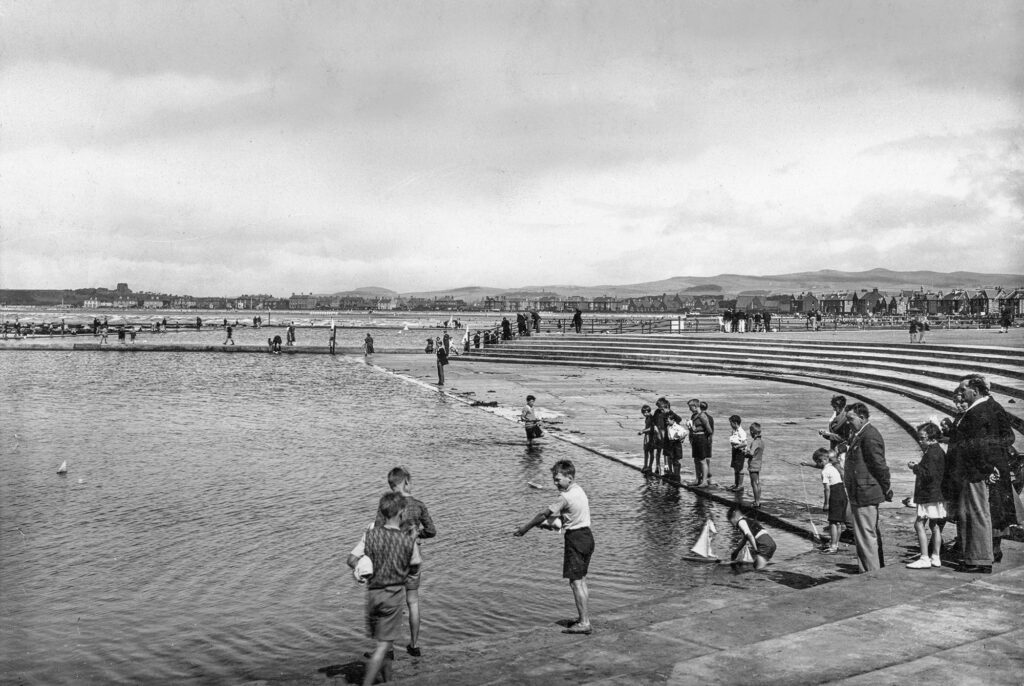

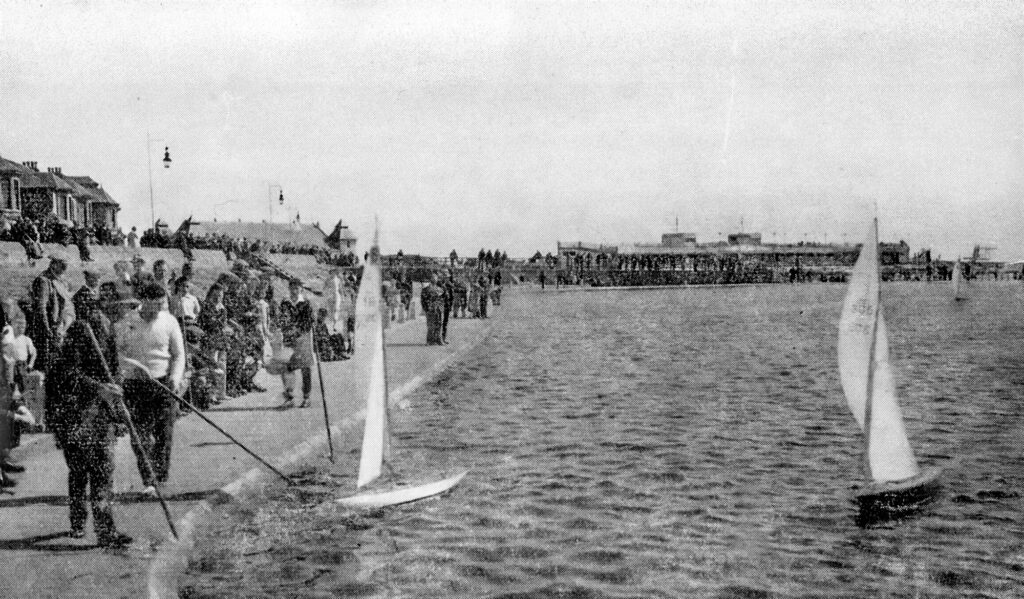
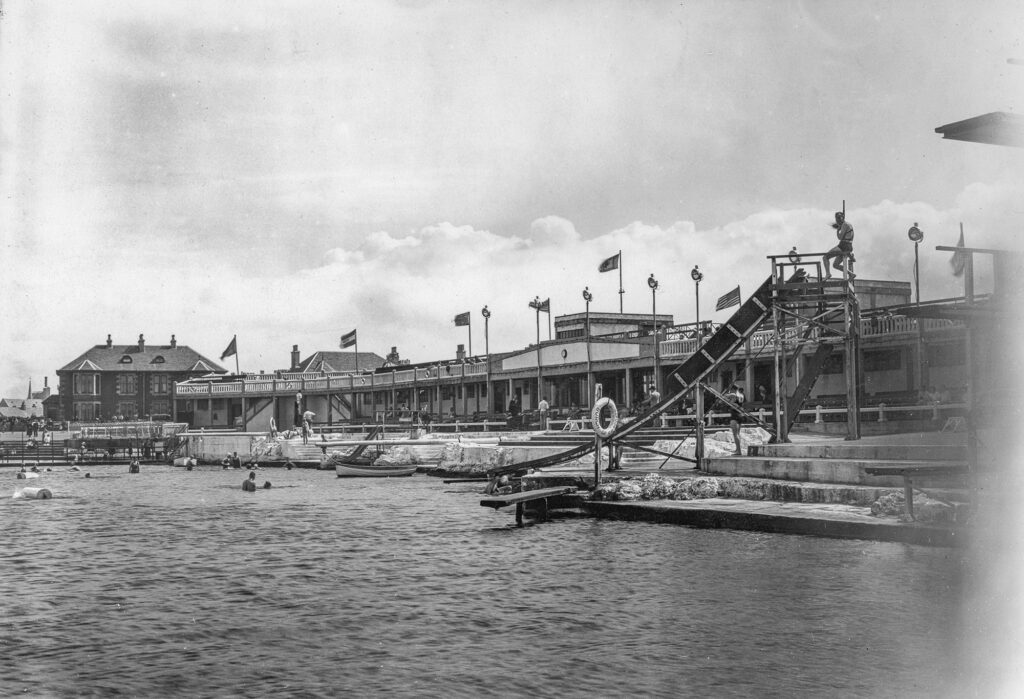
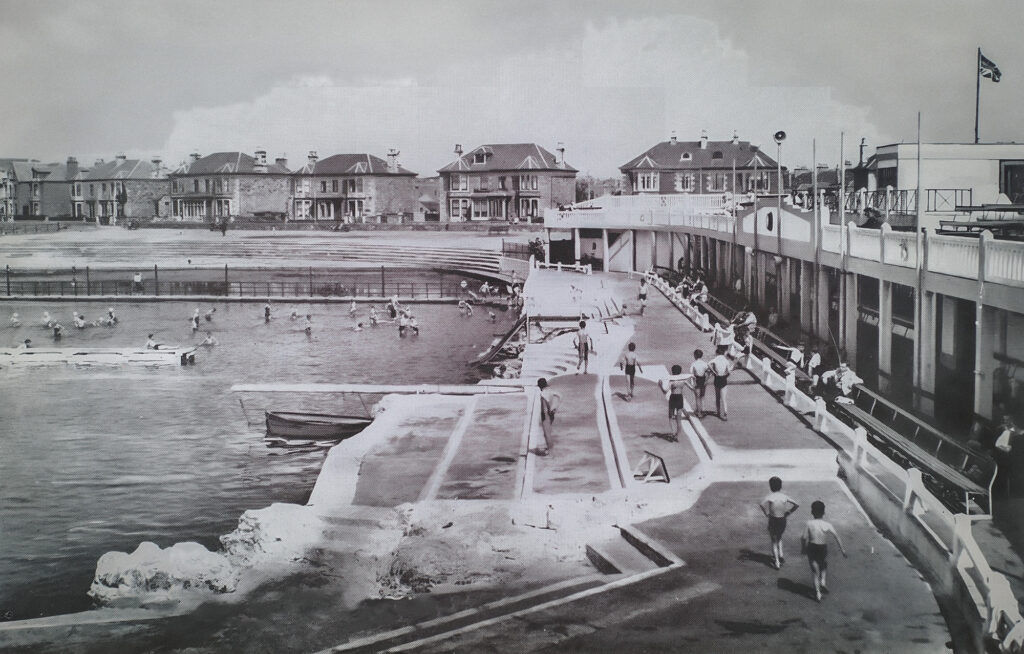
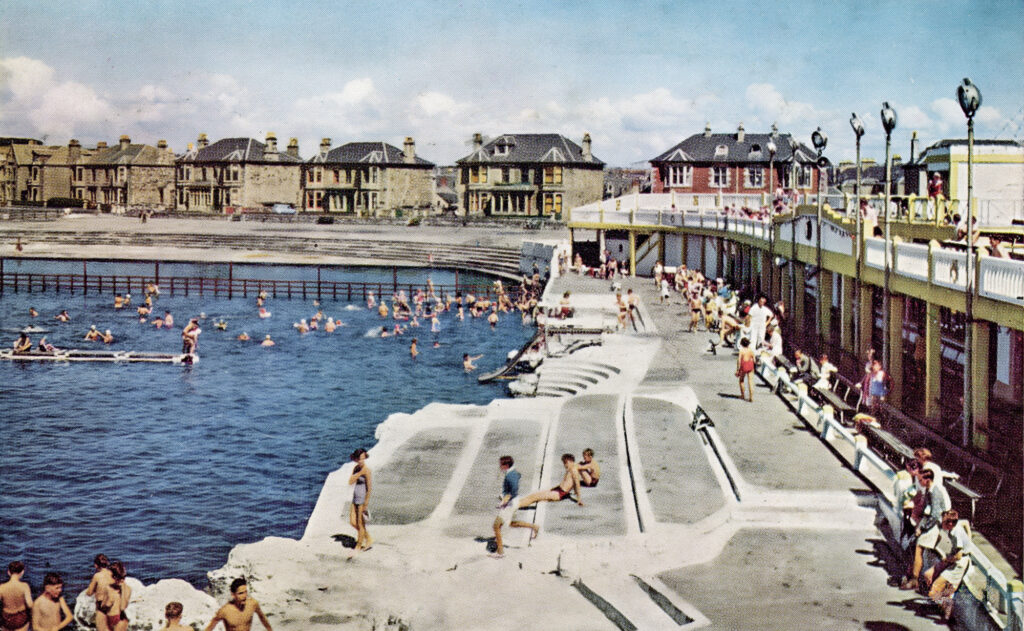
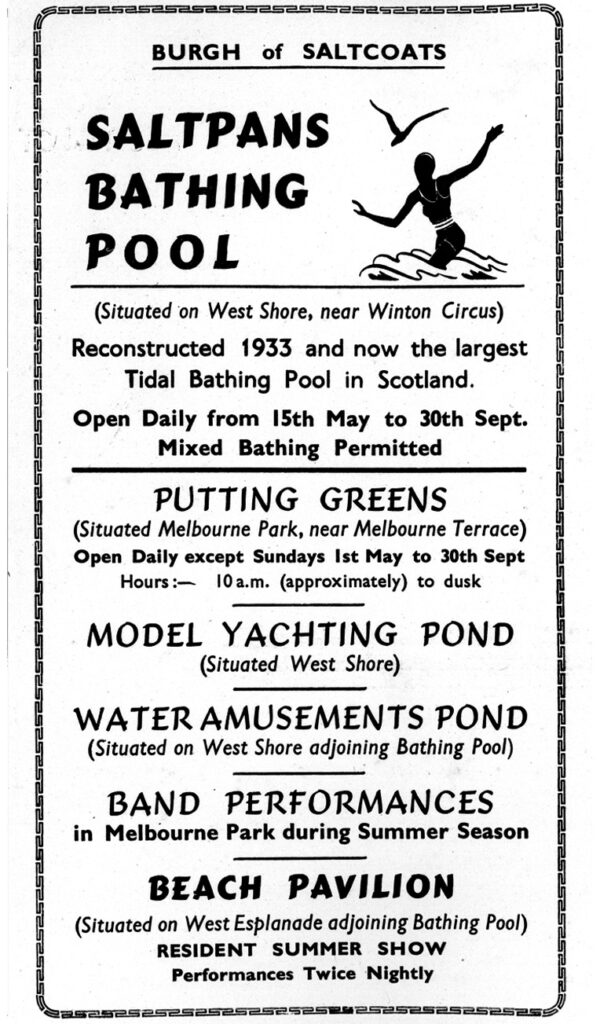
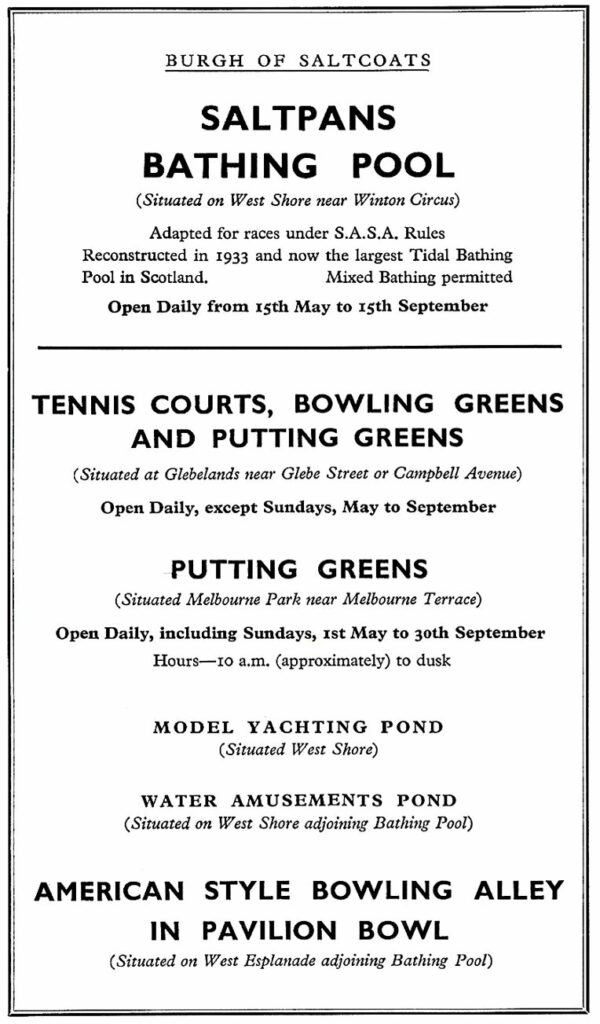
By the 1960s, further additions had been added to the area, including a roller-skating rink and children’s playground behind the terracing at the children’s boating pond.
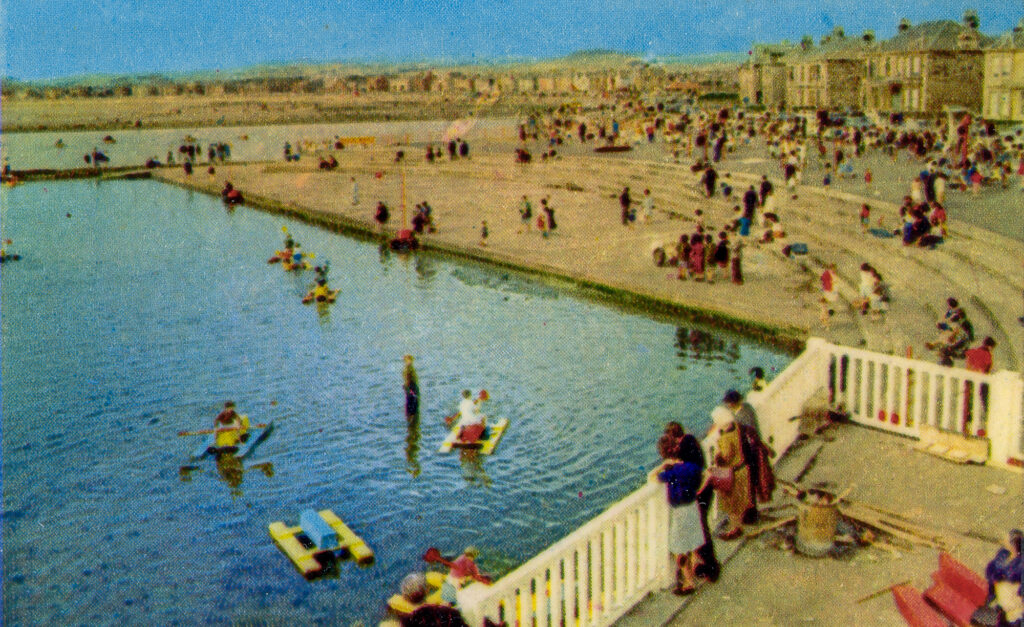
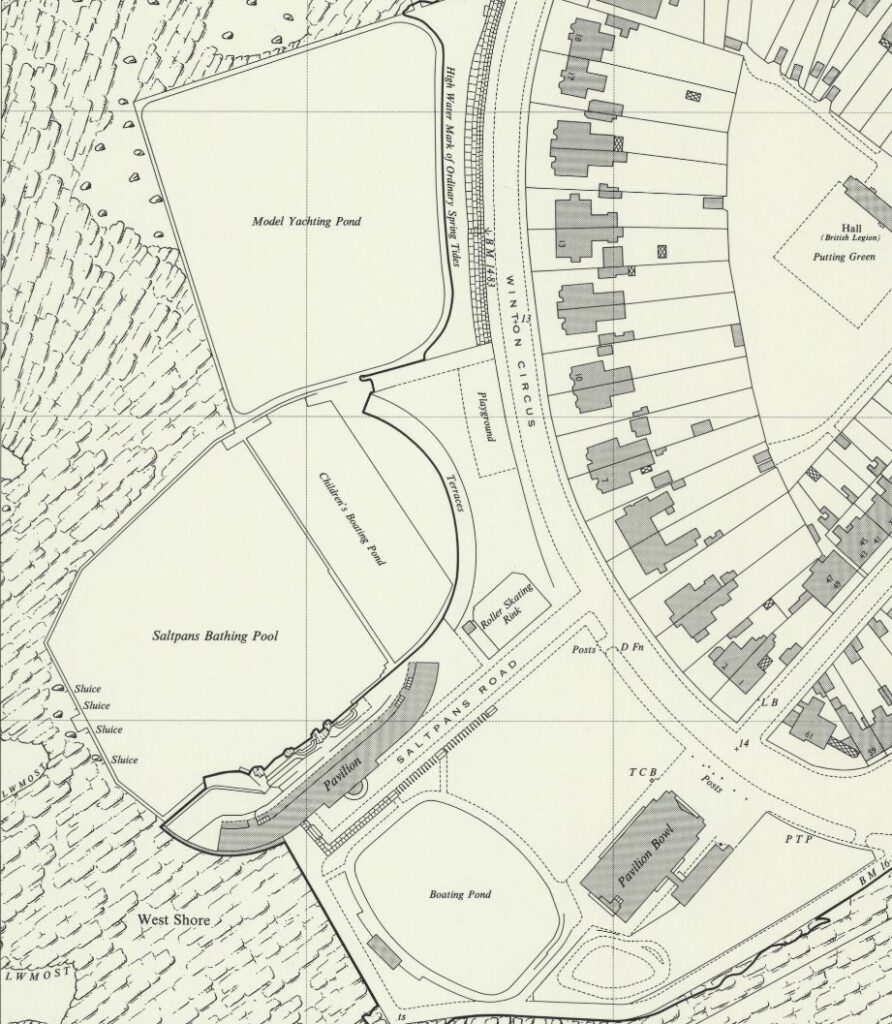
Final Days of the Saltpans Bathing Place
By the early 1970s Saltcoats had started to see a decline in summer visitors, caused somewhat by the rise of the package holiday abroad to warmer climates such as Spain. As a result, usage of the outdoor pool dwindled. An indoor pool was opened at the new Auchenharvie Leisure Centre in 1973, a joint effort between Stevenston and Saltcoats Town Councils to provide all year round swimming facilities.
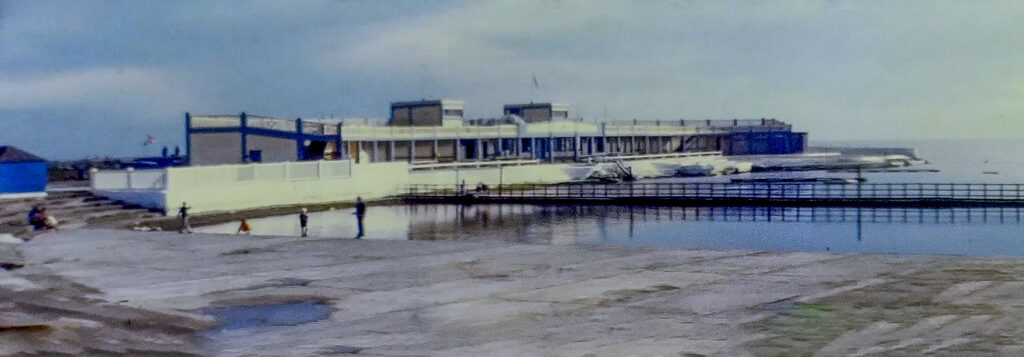
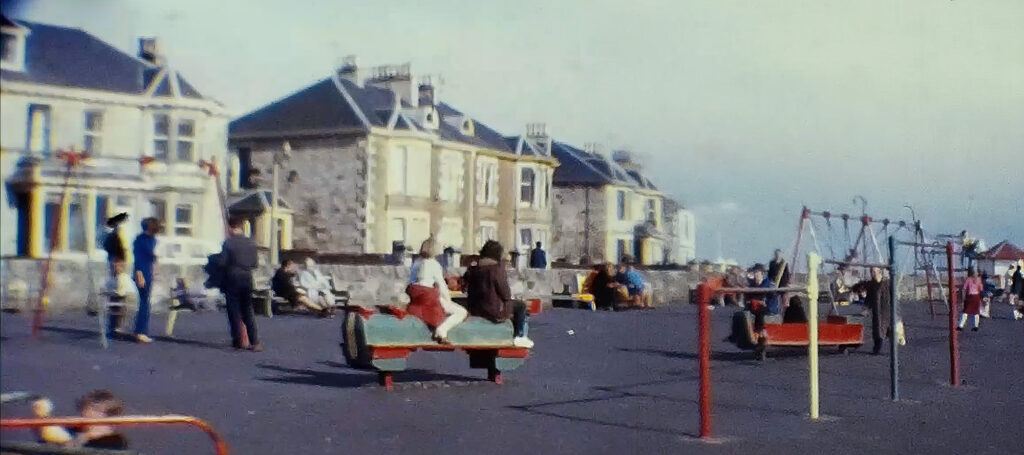
On its closure as a pool, the building was leased by the town council to Neil Gibson, who used it to expand his seafood business, “Saltpans Seafood”, which had been running alongside the pool during its last couple of years open. The council weren’t particularly keen to have such a large commercial venture operating on the sea front. Eventually Gibson’s company moved further north.
After lying empty for several years, the Saltpans Bathing Place was demolished in 1983. Within the next year, plans got underway to overhaul the site:
A campaign to assure Saltcoats’ status as a tourist resort into the next century has been launched. Several hundred thousand pounds are expected to be spent on the five acre site at the town’s old bathing pool and Cunninghame District Council is searching for a developer willing to transform the area into a permanent showground. It is hoped that the area, once its facelift is completed, will maintain and even expand the town’s tourist trade, paving the way for Saltcoats to remain a key holiday resort. Developers are being asked to submit ideas for a showground with a “fun park” theme incorporating two or three major temperatures. As the district council is shortly embarking on a project to upgrade the ponds area at Winton Circus, developers will have an opportunity to influence that work to tie in with their own plans. The council may even consider developing the land on a partnership basis. The idea has been sparked off by plans to give Saltcoats sea front a new look. Included in these plans is building in the Braes area which is the present home of a seasonal fairground.
From the Ardrossan and Saltcoats Herald, October 19th 1984 (courtesy of Tom McGrattan/Threetowners)
Although the plans were ambitious, the result didn’t live up to expectation. A new children’s swing park was built featuring a “pirate ship” amongst other attractions. The ship and other items were already at the site by late 1986/early 1987 but in temporary locations. Most of the redevelopment took place between 1987 and 1988: the original bathing pond was demolished, and a smaller pond was built in its place-including a new sluice to allow water to flow into the new pond. Both boating ponds were kept more or less intact.
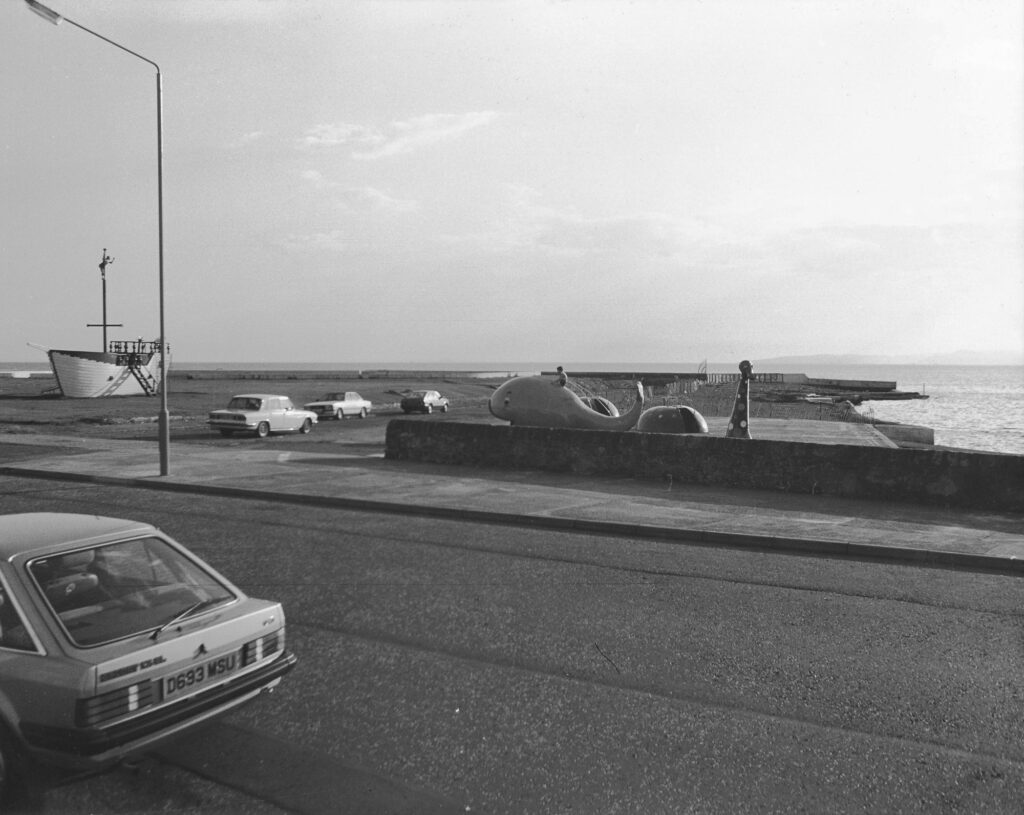
Saltpans Road was lifted and landscaped and some concrete terracing was built (similar in style to the terracing that was built in 1924). A lookout tower was built at the far end of the new pond, reminiscent of the nearby tower at the harbour. The tower also resembles a small castle, perhaps a callback to the ruins of the North Pans which were often said to look like a castle, or the legendary Castleweerock.
Legacy
For the next 30 years not much of note happened at the former Saltpans Bathing Place. The swing park was popular in the 1990s, but as time went on it started to fall into disrepair, and by the early 2000s some of the activities at the park had been removed, including the “pirate ship”. By the 2010s it only had some extremely basic playing equipment.
In the summer of 2021, local group Saltcoats Active Lifestyle Team (SALT), lead by Donna McGregor, pushed for a new swing park to be built. North Ayrshire Council agreed to make funding available, and so a brand-new park was opened in August 2022 to great success.
Also in 2021, Irene Campbell led the “Splash” group with plans to resurrect the outdoor pool. In collaboration with architect Chris Romer-Lee of Studio Octopi, the first design plans were made public at a meeting in Saltcoats Town Hall on 26th April 2023, just 2 days after the 130th anniversary of the Saltcoats Commissioners meeting in the same place to discuss the first improvements to be made to the bathing facilities in the area that eventually gave birth to the original Saltpans Bathing Place.
